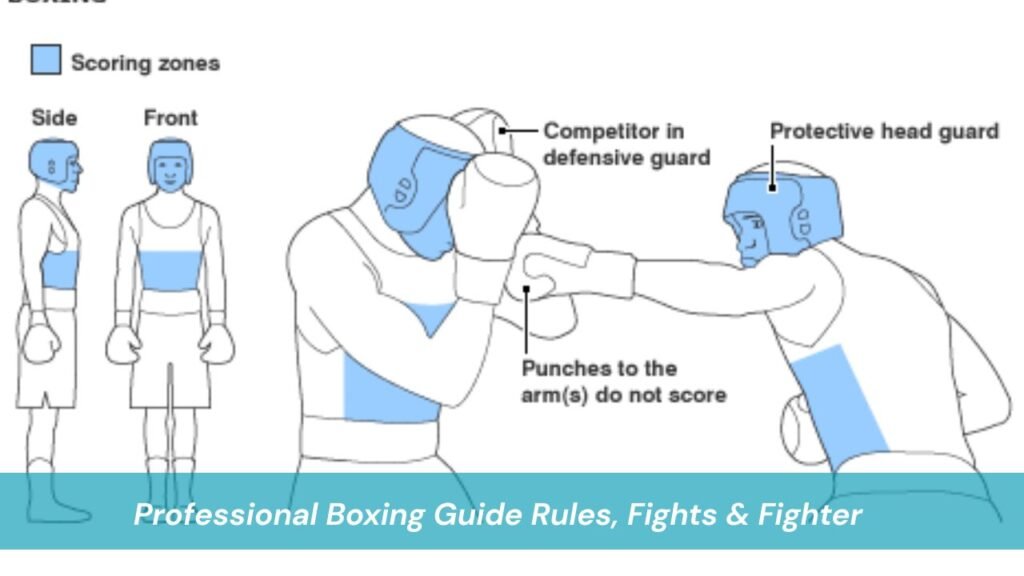Professional boxing is one of the most celebrated sports in the world, blending raw athletic ability, mental resilience, and dramatic storytelling. For more than a century, boxing has captured global attention through legendary fighters like Muhammad Ali, Mike Tyson, and Manny Pacquiao. Today, it continues to thrive as a sport that not only entertains millions but also provides a pathway for athletes to achieve fame and financial success.
This article provides an in-depth look at professional boxing, from its origins and rules to the business side of the sport and the steps involved in becoming a professional fighter. By the end, you will have a thorough understanding of why boxing continues to be one of the most captivating and influential sports across the globe.
What Is Professional Boxing?
Professional boxing is a regulated combat sport where two athletes face off in a ring, exchanging punches under a strict set of rules overseen by official organizations. Unlike amateur boxing, which often emphasizes scoring points in shorter bouts, professional boxing typically involves longer fights and carries higher financial stakes.
Each professional boxing match consists of a set number of rounds—most commonly between four and twelve with each round lasting three minutes. Fighters wear gloves and mouthguards for protection, but unlike amateurs, they do not wear headgear. The objective is to outscore or defeat the opponent through superior skill, strategy, and endurance. Victory can come in several ways: a knockout (KO), where one fighter is unable to continue after a legal punch; a technical knockout (TKO), where the referee stops the fight for safety reasons; or a decision by the judges based on performance throughout the rounds.
What makes professional boxing particularly compelling is the balance of athletic performance and mental strength. Fighters must train for years to master not only technique and endurance but also the ability to think strategically under immense pressure. This combination of physical intensity and psychological resilience is why the sport has remained popular for generations.
The History of Professional Boxing
The roots of professional boxing stretch back centuries. Early forms of prizefighting were popular in 18th-century England, where bare-knuckle contests were common. These fights often lasted until one fighter could no longer continue, and the lack of standardized rules sometimes made the sport brutal and chaotic.
The turning point came in 1867 with the introduction of the Marquess of Queensberry Rules, which laid the foundation for modern boxing. These rules established the use of padded gloves, timed three-minute rounds, and the concept of a ten-second knockout count. The adoption of these standards transformed boxing from a dangerous spectacle into a more regulated sport that prioritized fairness and safety.
Throughout the 20th century, professional boxing rose to global prominence. Champions like Jack Johnson, the first African-American heavyweight champion, broke racial barriers, while fighters such as Joe Louis, Sugar Ray Robinson, and Rocky Marciano became cultural icons. The mid-20th century is often referred to as the “Golden Age of Boxing,” with rivalries and personalities that drew massive crowds and international media coverage.
Today, boxing remains a worldwide phenomenon, with major title fights broadcast to millions of viewers. Organizations such as the World Boxing Association (WBA), World Boxing Council (WBC), International Boxing Federation (IBF), and World Boxing Organization (WBO) govern the sport at the highest level, ensuring that fighters compete within clearly defined rules.
Rules and Regulations in Professional Boxing
Professional boxing operates under a strict set of rules designed to protect fighters and maintain competitive fairness. Each match is divided into timed rounds, usually lasting three minutes, with one-minute breaks between them. The number of rounds varies depending on the level of the bout, with championship matches often scheduled for twelve rounds.
Weight classes are another key aspect of regulation. To ensure fair competition, fighters must compete against opponents of similar body size and weight. Boxing has seventeen recognized weight classes, ranging from minimumweight (105 pounds) to heavyweight (over 200 pounds). This classification system prevents mismatches that could lead to serious injury.
Scoring in professional boxing is determined by judges who evaluate each round using the 10-point must system. The fighter deemed to have won the round is awarded ten points, while the opponent receives nine or fewer depending on performance. Knockdowns typically result in a 10–8 score. Judges consider several factors when scoring, including clean punches, effective aggression, defensive skill, and ring generalship—the ability to control the pace and flow of the fight.
Fouls are strictly prohibited. Fighters are not allowed to hit below the belt, use elbows, hold excessively, or punch after the bell. Referees play a crucial role in enforcing these rules, stopping fights when necessary to protect the health of the boxers. Medical supervision is also mandatory. Fighters undergo medical examinations before and after each fight to ensure they are fit to compete.
The Business of Professional Boxing
Beyond the ring, professional boxing is a multibillion-dollar industry. Fighters, promoters, trainers, managers, and broadcasters all play essential roles in shaping the sport’s economy.
Boxers earn money primarily through fight purses, which are negotiated before a match and divided between the competitors. The size of a purse often depends on the popularity of the fighters, the importance of the event, and broadcasting rights. For top-tier fighters, these purses can reach extraordinary figures. Floyd Mayweather Jr., for example, earned over $300 million from his 2015 fight against Manny Pacquiao, making it one of the most lucrative events in sports history.
In addition to purses, pay-per-view (PPV) events have become a cornerstone of boxing’s business model. High-profile fights attract millions of viewers willing to pay for exclusive access, generating massive revenue for both fighters and promoters. Endorsements and sponsorships further add to a boxer’s income, with global brands often eager to associate themselves with successful athletes.
Promoters play a pivotal role in professional boxing, organizing events, securing venues, and negotiating television deals. Legendary promoters like Don King and Bob Arum helped shape modern boxing by bringing major fights to the global stage. Today, promotional companies such as Matchroom Boxing and Premier Boxing Champions continue that legacy.
The Path to Becoming a Professional Boxer
The journey to becoming a professional boxer is demanding and requires years of dedication. Most fighters begin in amateur boxing, competing in local, national, or even Olympic-level tournaments. This stage is crucial for developing skills, gaining experience, and building a reputation.
Once a fighter decides to turn professional, they must apply for a license from their regional or national boxing commission. This process often involves medical examinations to ensure the athlete is physically capable of competing. With a license in hand, the boxer can then begin their professional career.
Early professional fights are often against relatively unknown opponents, serving as opportunities to gain experience and build a record. A boxer’s win-loss record is a critical factor in their career, as it influences rankings, title opportunities, and fan support. Over time, consistent victories and impressive performances can lead to higher-profile matches and eventual championship opportunities.
Climbing the rankings requires not only skill but also strategic career management. Fighters work closely with managers and promoters to select opponents that will help advance their standing while minimizing unnecessary risks. It is a delicate balance of athletic ambition and business acumen.
Why People Love Professional Boxing
Professional boxing’s enduring popularity lies in its ability to combine athletic skill, human drama, and global representation. Each fight tells a story, whether it’s a rivalry between two champions, an underdog’s rise to glory, or a redemption arc for a fallen star. Fans are drawn not only to the action inside the ring but also to the personal journeys of the athletes.
The sport also appeals to a diverse audience because champions come from all corners of the world. From Mexico’s Julio César Chávez to the Philippines’ Manny Pacquiao, from Britain’s Anthony Joshua to Ukraine’s Oleksandr Usyk, boxing offers global representation unlike many other sports. This diversity fosters international rivalries and cultural pride, further fueling the excitement.
Perhaps most of all, fans love boxing because of its unpredictability. Unlike many sports where outcomes can be anticipated, a single punch in boxing can completely alter the result of a fight. This element of surprise keeps audiences on edge, ensuring that every bout remains captivating until the very end.
Frequently Asked Questions
How long does a professional boxing match last?
A typical professional boxing match lasts anywhere from four to twelve rounds, depending on the level of competition. Each round lasts three minutes, with one-minute intervals for rest. Championship fights almost always extend to the full twelve rounds.
What is the difference between amateur and professional boxing?
Amateur boxing is often seen at the Olympic level and focuses on scoring points with clean punches. Fighters usually wear protective headgear, and matches are shorter. Professional boxing, on the other hand, features longer fights, greater financial rewards, and more emphasis on endurance, power, and entertainment.
How do fighters get ranked in professional boxing?
Rankings are determined by sanctioning bodies such as the WBA, WBC, IBF, and WBO. Fighters climb the rankings by winning sanctioned fights, maintaining an active record, and defeating higher-ranked opponents. Rankings are critical because they determine eligibility for title fights.
Is professional boxing dangerous?
Professional boxing does carry risks due to its physical nature. Fighters face potential injuries ranging from cuts and bruises to concussions. However, modern regulations, medical supervision, and protective equipment are designed to reduce risks as much as possible. Fighters must undergo regular medical exams and follow strict safety protocols.
Can anyone become a professional boxer?
In theory, anyone with enough dedication, training, and physical ability can pursue a career in professional boxing. However, it requires years of disciplined training, a strong support network of coaches and managers, and the resilience to handle both the physical and mental challenges of the sport.
Conclusion
Professional boxing remains one of the most fascinating sports in the world, blending history, discipline, and entertainment in a way that few other activities can match. From its roots in bare-knuckle contests to the modern global stage of pay-per-view super fights, the sport has evolved while maintaining its timeless appeal.
Whether you are a fan who enjoys the thrill of watching a twelve-round battle, an aspiring fighter dreaming of championship glory, or simply someone curious about the rules and history of the sport, professional boxing offers endless opportunities to learn, be inspired, and be entertained.




